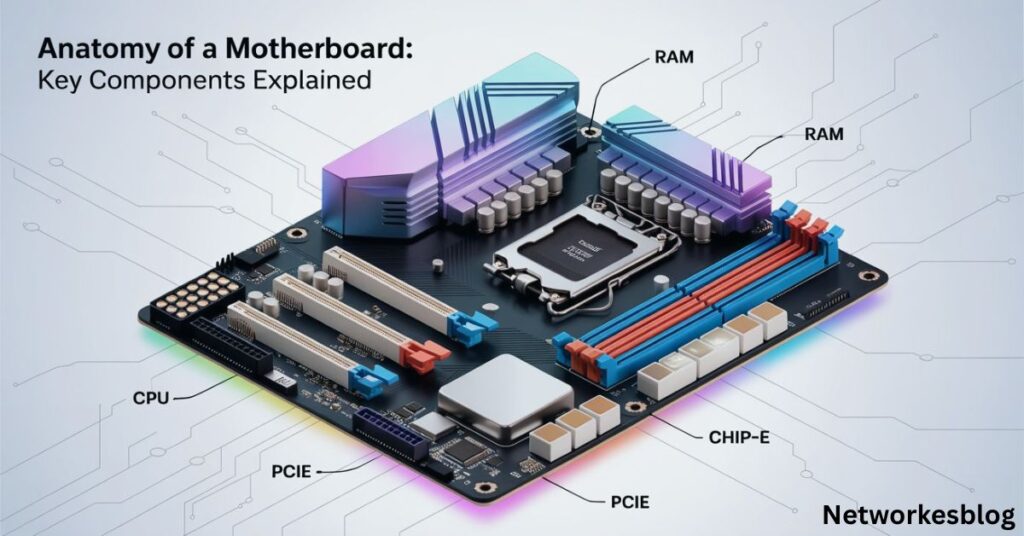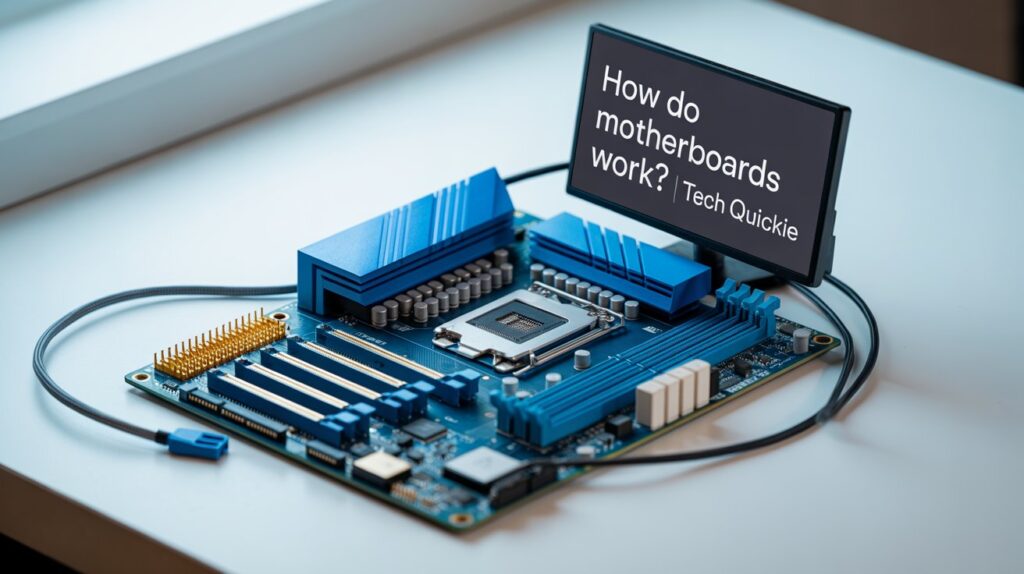Curious about how your computer functions? This guide answers the question, how do motherboards work tech quickie, by breaking down the core components and their roles in your PC. Learn how the motherboard connects your CPU, RAM, storage, and other hardware to keep everything running smoothly.
Whether you’re building a PC or just exploring tech basics, this article offers a quick and clear explanation of how motherboards work. Ideal for beginners and enthusiasts alike, this tech quickie simplifies complex topics into easy-to-understand insights. Get the knowledge you need to make smarter tech decisions today.
What Is a Motherboard? (The Core Definition)
A motherboard, sometimes referred to as a mainboard or logic board (especially in Apple devices), is the central printed circuit board (PCB) in a computer. It provides the foundational infrastructure for all other hardware components to connect, communicate, and work together.
The Role of the Motherboard:
- Physically hosts components like the CPU, RAM, GPU, and storage.
- Transfers power to each part.
- Enables data communication between hardware.
- Provides ports and connectors for external devices.
- Houses firmware (BIOS/UEFI) to boot and manage the system.
Without a motherboard, a computer simply cannot function.
Anatomy of a Motherboard: Key Components Explained

Let’s take a closer look at the essential parts of a motherboard and what they do.
CPU Socket
This is where the Central Processing Unit (CPU) is installed. Each socket type supports a specific set of processors. Intel and AMD use different socket standards (e.g., LGA1700 for Intel 12th/13th Gen, AM5 for AMD Ryzen 7000 series).
RAM Slots (DIMM Slots)
These slots hold your system memory (RAM), which is crucial for multitasking and running applications smoothly. Most modern motherboards support dual or quad-channel memory configurations.
Chipset
The chipset controls communication between the CPU, RAM, storage, and peripheral devices. It often determines the features available on your motherboard (USB ports, PCIe lanes, RAID support, etc.).
Examples:
- Intel Z790 – performance chipset with overclocking support
- AMD B650 – budget-friendly with decent feature set
Expansion Slots (PCIe)
Used to install add-on cards like:
- Graphics Cards (GPUs)
- Sound Cards
- Wi-Fi Cards
- Capture Cards
Modern graphics cards typically use PCIe x16 slots for maximum bandwidth.
Storage Interfaces
Motherboards include connectors for storage devices:
- SATA for traditional SSDs and HDDs
- M.2 NVMe slots for ultra-fast solid-state drives
Power Connectors
The motherboard receives power through:
- A 24-pin ATX power connector
- An 8-pin (or 4+4) CPU power connector
These deliver the required voltages and currents to the CPU and other components.
BIOS/UEFI Firmware
This built-in firmware initializes and tests hardware during startup. It also provides settings for overclocking, boot order, fan control, and more.
Rear I/O Panel
Includes essential ports for external devices:
- USB ports (USB 2.0, 3.0, 3.2, Type-C)
- Ethernet (LAN) port
- HDMI/DisplayPort (if onboard graphics are supported)
- Audio jacks
- PS/2 for older peripherals
Internal Headers
Used for front-panel connectors and case components:
- Power/reset buttons
- USB ports
- Front audio
- RGB lighting
- Fans
How Does a Motherboard Work? (Step-by-Step)
Let’s understand how all these parts work together to power your PC.
Step 1: Power-Up
When you press the power button, the power supply unit (PSU) sends electricity to the motherboard. The board distributes it to the CPU, RAM, storage, and other connected devices.
Step 2: POST (Power-On Self-Test)
The motherboard runs diagnostic tests using the BIOS/UEFI firmware. It checks the memory, CPU, storage devices, and more.
Step 3: Booting the OS
Once the POST completes, the motherboard looks for the bootable drive (usually an SSD or HDD with Windows, Linux, etc.). It passes control to the operating system, which begins loading.
Step 4: Continuous Management
Even after booting, the motherboard continues managing:
- Data traffic between CPU, RAM, and storage
- Thermal regulation through fan and temperature sensors
- Input/output operations (mouse, keyboard, USB devices)
Why Is the Motherboard So Important?
The motherboard is more than a piece of hardware — it determines:
- What CPU you can use
- How much RAM you can install
- Your storage and expansion options
- How fast and stable your system performs
- Whether you can upgrade components in the future
Choosing the right motherboard means building a system that fits your goals, whether it’s gaming, content creation, or casual use.
Types of Motherboards: Which One Do You Need?
ATX (Full Size)
- Standard size (12″ x 9.6″)
- Offers most features and expandability
- Ideal for gamers and power users
Micro-ATX
- Smaller (9.6″ x 9.6″)
- Fewer expansion slots
- Great for budget builds
Mini-ITX
- Very compact (6.7″ x 6.7″)
- One PCIe slot
- Used in small form factor (SFF) PCs
Make sure your case supports the motherboard size you choose.
How to Choose the Right Motherboard
When shopping for a motherboard, consider these factors:
✅ CPU Compatibility – Match the socket and chipset to your processor.
✅ RAM Support – Look for max supported memory and speeds.
✅ Expansion Slots – Ensure enough slots for GPU and other cards.
✅ Storage Options – Need M.2 for NVMe drives? Check availability.
✅ Connectivity – Look for USB-C, Wi-Fi 6, Bluetooth, and high-speed Ethernet.
✅ BIOS Features – Some boards offer advanced fan control and overclocking support.
Common Motherboard Brands
Some trusted motherboard manufacturers include:
- ASUS (ROG, TUF, Prime)
- MSI (Tomahawk, Pro, MAG)
- Gigabyte (AORUS, Ultra Durable)
- ASRock
- Biostar
Each brand offers unique BIOS features, software, and durability levels.
Fun Fact: Why Is It Called a “Mother” Board?
The term “motherboard” comes from its role — like a mother, it nurtures and connects all the other components (sometimes called “daughterboards” when they plug into it).
FAQs
Can a motherboard bottleneck performance?
Yes, especially if it doesn’t support the full potential of your CPU, RAM, or storage speeds.
Do I need a new motherboard when upgrading my CPU?
Often yes. CPU upgrades may require a newer socket or chipset that your old motherboard doesn’t support.
What’s the difference between BIOS and UEFI?
UEFI is the modern replacement for BIOS with better graphics, faster boot times, and more features.
Can motherboards be repaired?
In some cases, yes — but motherboard repairs are complex and often not worth it compared to replacement.
What does a motherboard do in a computer?
A motherboard connects and powers all hardware components, allowing them to communicate and function together.
Conclusion:
Understanding how motherboards work gives you a big advantage whether you’re building, upgrading, or troubleshooting a PC. It’s the unsung hero of your setup — quietly connecting, powering, and managing everything behind the scenes.
Before you build or buy, make sure your motherboard is the right foundation for your computing goals. It may not be as flashy as a GPU or as fast as an SSD, but it’s the part that keeps everything working in perfect harmony.
Also Read:
Project Zero Motherboard: Revolutionizing Cable-Free PC Builds
AM4 vs AM5: Which AMD Platform Should You Choose in 2025?
Motherboard Capacitor: A Complete Guide to Function, Failure, and Maintenance
